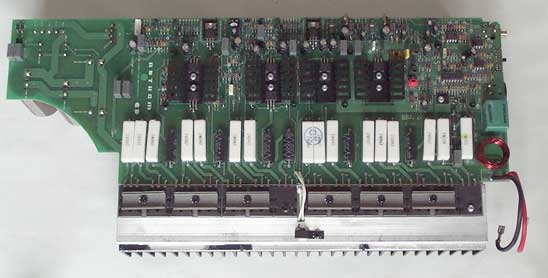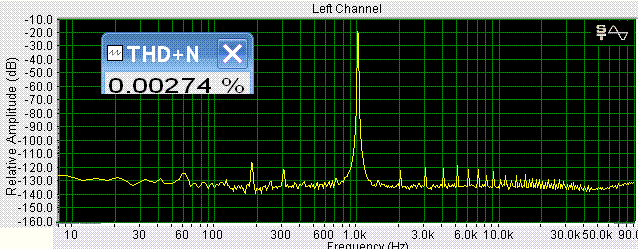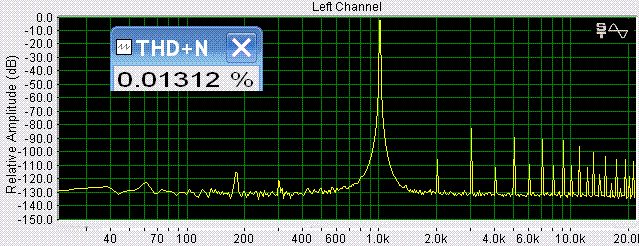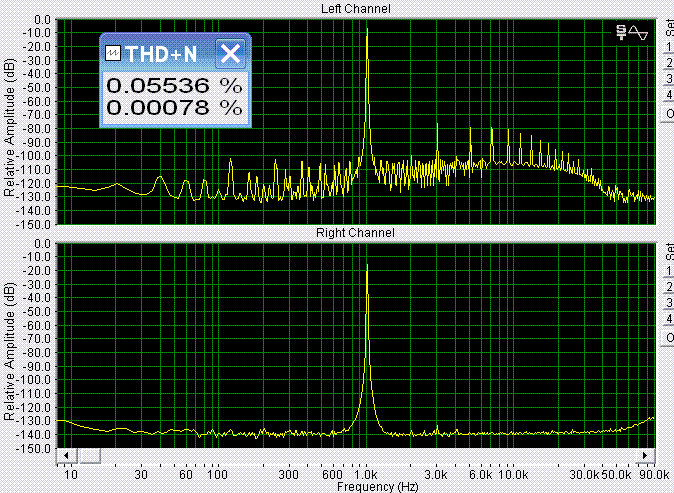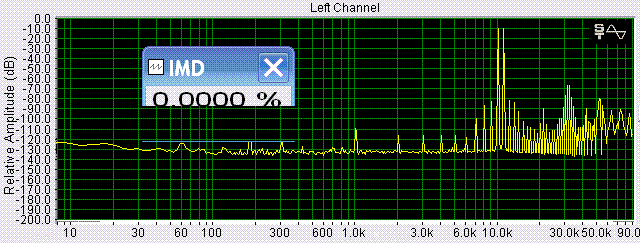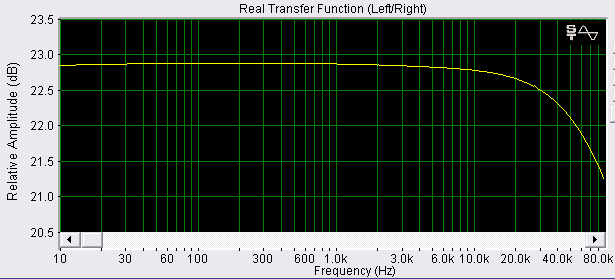|
||||||||
|
Introduction Have you ever visited an uber high-end audio shop where the salespeople only have two modes? Mode 1: Ignores the guy in the jeans who drove up in the non-European car since he cannot possibly afford anything in here. Mode 2: Walks around looking over your shoulder to make sure you do not touch anything . . . again, because you cannot afford it. The reality is that most of us cannot afford the items in those shops, and some of the salespeople treat us like they know that we can't afford them. However, over the years I have meet some exceptional salespeople who simply love what they sell and are willing to allow anyone - wealthy or otherwise - to audition components that have more money in cables connecting them together than we paid for our last car. I wish there were more of this type of salesperson. While you were in that shop, I am sure you noticed the amp on the floor, sitting between the speakers. The one that resembled the size of your wife's suitcase the last time you went on a two week vacation. That amp may have carried the name Mark Levinson, or there might have been two of them branded Sim Audio. Do you remember the sales guy telling you the price? You probably don't remember your jaw hitting the floor, but it was probably sore the next day? Those are the same feelings I got the first time I saw the Statement Series of amplifiers from Anthem. They are not quite as big as the largest Levinson amps, but they are very close. As well, they are not quite as impressive looking, but they are very close. However, when I heard the price, my jaw closed again. Anthem Statement P5 I am sure the Anthem Statement Series was a dream come true for someone at Anthem. The P5 reviewed here is a five-channel amp that outputs 325 watts per channel into 8 ohms, 500 watts a channel into 4 ohms, an even larger amount into 2 ohms, and is claimed stable to 0 ohms (well 0.05 ohms since there is resistance in anything you place between the outputs). Someone said you could put a fork across the binding posts and make some pretty horrible sounding music for 8 seconds or so until the breaker popped to avoid melting your house wiring. If you are like me you are thinking, "This is great, but I only have a 15 amp circuit and at 110 volts that only allows for 1,650 watts to be shared across all 5 channels". Someone at Anthem had the same line of thinking, so they provided two AC power cords. So, you can feed this one amp from two separate 15 (or 20) amp circuits. A quick calculation of 650 watts by 5 channels requires 3,250 watts to sustained output and 15 amps x 2 circuits x 110 volts will have a potential of approximately 3,300 watts, which should just cover the minimum. To be truthful, I do not imagine many people will ever use 650 watts a channel – all channels driven – for a length of time to actually deplete the power supply's reserve, but it does provide some level of comfort knowing you will never run out of power. You will also have comfort in knowing that even though 99% of the time, you never use more than 10 watts, when the canon fires in the "1812 Overture" or an entire city block explodes in the action film you are watching, the P5 will produce the full dynamic range without even breaking a sweat. Even our Editor-in-Chief's ribbons, electrostats, and other speakers that create impossible loads on amplifiers would not begin to tax this amp. Likely, you are wondering what happens if you do not have two 15 amp
circuits. I tested the Anthem with a single power cord, a pair of power cords
plugged into the same circuit, and with both power cords plugged into two
separate circuits. In all three cases, the amp performed flawlessly without
any degradation in sound quality (at least not at the power levels required
for my room and speakers). Anthem has taken special care to include a soft
turn-on circuit to avoid the huge in-rush of current that would trip your
breaker(s). Power cord tweakers be warned . . . you are going to need to
upgrade two cords with the P5. Those of you with bad grounds in your homes will appreciate the
fact that the P5 does not have an earth ground connection on the
dual IEC power sockets, which should keep ground loops at bay.
The Design
The P5 is a modular design where each channel is a completely separate monoblock. Each module consists of its own very large toroidal transformer, two independent secondaries feeding the input stage and output stage, fourteen output devices, and a big chunk of iron to be used as a heat sink. These modules all sit inside of a single chassis attached with an amazing number of machine screws. It takes about 15 minutes just to remove the cover with a standard screwdriver (thank goodness for cordless drills).
The input stage is a series of four transistor pairs (eight in total). The first four are two complimentary feedback pairs that correct each other's non-linearities with local feedback. These are followed by another pair in a cascode configuration to gain more bandwidth and stability that are in-turn connected to an active load pair. The output stage of seven push-pull pairs of bipolar transistors in parallel allows for driving any speaker load. Nick Platsis explained Anthem is not even running the transistors to their limits to keep the heat down, allowing for more stability, longer reliability, and my personal favorite - completely passive cooling (no fans).
The front of the chassis is all aluminum with some very attractive blue lights, one for power and five channel status lights. The only color available is black with a silver power button. I was interested to see if the light would flicker or change color at the edge of clip. However, even during the amazing abuse we put this amp though, neither the lights nor the amp faltered. On the top of the amp are five circuit breakers for protection in case something goes wrong. The breakers are on the AC input side of the circuit, rather than the outputs. Anthem uses a circuit called Advanced Load Monitoring (ALM) to monitor temperature, current, and voltage to trip the AC source in the event you could actually push one of the channels to its limit. But, if you drive the amp that hard, let me know, so I can buy some stock in Beltone (hearing aids). Anthem has included both balanced and unbalanced inputs. Small dip
switches controls the type of input chosen for each channel and balanced
inputs can be attenuated by 6 dB. This allows for closer input level matching
in the case you are using a mix of balanced and unbalanced inputs or in the
case your preamp requires it for proper levels to be achieved. The speaker
connections are high quality clear plastic covered gold-plated binding
posts. They are large enough you could easily tighten down bare wire without
hurting your fingers.
Power can be engaged in three different ways. The first is simply the power switch, the second is via a 5 or 12 volt trigger, and the third is auto-sensing an input signal. The mode chosen is controlled with another switch on the rear of the amp. The back of the amp has handles to help maneuver the unit, but you will need two people if you plan to move it around anywhere. The front is particularly heavy (and lacks handles) as the five toroidal transformers are located there. In my setup, I cannot even push the amp around to move it, as the weight of the amp puts so much force on the six large rubber feet, the frictional force cannot be overcome. In order to move the amp I had to ask a friend to help me lift it and move it to another spot. This product is a definite candidate for an amp stand with wheels. And the Smoke Stayed In Being the technical geek I am, I figured one would want to ensure the wheels stayed on in stressful situations, so we started with the stress tests before audio evaluation. As an aside, note you should not try this at home; serious damage could occur to you or your equipment and I am pretty sure you could start a fire. We also asked Anthem specifically if it was fine to use a fork as a speaker. They didn't say no, leaving us with only a simple warning: use a fork with a long handle, as it might get a little warm. First task at hand was to pop those little breakers on the top of the amp without tripping the AC breaker in the wall panel. I was pretty sure if I shorted the binding posts together, the ALM circuitry would pop the breaker when it detected the short. Guess what, it didn't. If you remember the requirement of the ALM, it monitors for temperature, current, and voltage, and even though the output was shorted, the resistance was a very small number like 0.02 ohms. With no signal at the input, the amp was stable with the almost-shorted load. This was impressive, because even a small amount of noise in this situation would cause the output to trip (or burn up) in 90% of amps on the market just due to the current requirements. Increasing the input to 1 volt managed to get the breaker to pop, but not before the fork screeched out some horrible sound (yes a fork will reproduce 1 kHz if you put enough voltage across it and current though it). After about 3 seconds, there was a click, the fork silenced and the little round breaker popped up on top of the amp. I made sure all other four channels still functioned, and they did (as they should since all channels are true mono-blocks). While this test really doesn't prove much from an audio perspective, it was fun to try, and shows us that the P5 power supplies have enormous capacity. The Sound The P5 is big, heavy, and pretty much unbreakable, but what does that mean in terms of audio quality? To put it simply: Amazing! The Statement P5 provides great control over any speaker. It is a shame I do not own some electrostats which are a much more difficult load to drive. Even setting all speakers as full range and removing the sub from my system, I could not begin to stress this amp (although I must admit I missed the low frequency extension of the sub). Even at very high SPL, the P5 sounded as clear and neutral as it did during late night listening. Amps of this size often sacrifice low listen levels for overall power. In particular, a couple of the larger (200+ watt/channel) amps I have owned exhibited a hiss or hum in the speakers which was audible at low listening levels. With the P5, the speakers are pretty much dead quiet with only a very slight hiss from the tweeters if you put your ear right next to it. Listening to quiet passages, late at night, are as clear as I would expect from a pair of high quality headphones. At the opposite end of the scale, I worry that powerful amplifiers will end up sounding more like PA equipment. Anyone who has used PA equipment as home stereo gear (I was a DJ in an earlier life) knows that the equipment (amps, speakers, etc.) are typically very bright and edgy. The Statement P5 is certainly not bright; it is clean and detailed, without ever sounding harsh. I would even suggest the P5 is a slightly warmer sounding amp than a Bryston, but not as warm as a B&K. Even after long extended listing sessions, I experienced no sign of listener's fatigue. P5 reproduction of movie sound tracks is very impressive. It is unfair to say the P5 brought movies to a new level, but it is certainly the best I have ever experienced in my home theater. Explosions are reproduced with the full impact the director intended and dialog is maintained without the need to continually adjust the volume. Music is reproduced equally well. I spent a large amount of time listening to DVD-Audio discs during my time with the P5. The Steely Dan DVD-Audio discs showed off the musicality and clarity of the P5. Changing genres to big band music like Big Phat Band or Les Brown simply reinforced the P5's strength and dynamic range. To go on and on about different music would be pointless, but let me simply say there is not a single source, media type, or genre that the P5 will not compliment. The P5 has been set up in two different listening environments during the time I had it here. During that first period of time I felt the amp was a stellar performer with much the same neutral sonic characteristics as my Cinepro. This is a big compliment since the Cinepro is my reference and was an end to a long quest of listening to amps in order to find one with what I considered to have perfect sonic properties (limitless power, incredible signal-to-noise ratio, perfect dynamics for quiet late night audio session, as well as impact for movie night with the guys). After I was done with the listening, I boxed it up, but then I unpacked it to re-measure it (I will discuss this in a few minutes). I had recently completed a dedicated home theater, so I figured why not try the amp again (besides it was a shorter lift than back downstairs). This was an interesting experience, since I was again replacing the same Cinepro amp with the P5. What I discovered was a new found lower noise floor, something I didn't think was possible. The Cinepro which I had been using for quite some time sounded like it lacked a bit of dynamics at lower listening levels in the new theater. This was mainly due to the lower noise floor of the new room (which is somewhat soundproofed). In the most extreme circumstances, I could even hear the fan in the back of the Cinepro. The P5 upon re-entry to the system gained a new respect as it had actually surpassed my reference. As a side note, this all becomes a mute point as soon as you put a high-definition PVR in the room which makes more noise than an HTPC. On the Bench This review is long over due. The main reason is that my current travel schedule does not allow for much time at home. However, we had one major setback during the review period. We surpassed the measuring capabilities of our equipment. Equipment reviewed here was previously measured using a WaveTerminal 192X sound card. The Waveterminal is a good 24/192KHz card, but did not have the noise floor specification to properly measure the P5. Upgrading the sound card to a Balanced Lynx L22 (the same card we use for measurement in California) provided us with the extra dynamic range we needed to properly measure the P5. Looking at the results you can see there are times when even the L22 does not have enough headroom to completely expose the specification of the P5. In all of the measurements below, the left channel represents the P5 feeding a series of 300 watt resistors configured for an 8 ohm load. The output voltage of the P5 is sent though a voltage divider to reduce the signal to a level which will not overload the input of the Lynx sound card. A 1 kHz tone at 10 watts shows a very low THD+N measurement of 0.003%. You will notice the looped soundcard shows a higher THD+N because the very low output of the sound card is forcing the noise measurement on the input to be the major contributing factor in the calculation.
Increasing the input voltage to achieve 190 watts on the output we see the THD+N increases to 0.008% which is still very low.
At 325 watts, Anthem claims THD+N should be no higher than 0.1%. Our measurement show 0.01%, which is an entire order lower in magnitude. I really appreciation manufacturers who under-rate their equipment.
Leaving the amp at 325 watts output and shifting the input signal to 5 kHz, the P5 achieves a THD+N of 0.07%.
All the tests above remain within the specs of the amp, but I had 1200 watts worth of resistance and the P5 is claimed to be stable at two ohms. In order to test this, I reconfigured the resistors to a 2 ohm load and started increasing the input voltage to see where the amp started to clip. At 780 watts (as shown in the graph below) the four ceramic coil resistors were screaming out 1 kHz. While it was the worst reproduction of a 1 kHz tone I have ever heard, the resistors had effectively become speakers. To assure the resistance hadn't changed (the resistors were starting to get a little warm) immediately after disconnecting the signal the resistance was re-measured and it remained at 1.8 ohms right where we started. The right channel loop-through is shown in this graph to indicate the sound card's distortion level by comparison.
IMD measurements are also better than specification at 0.0003% using 5 kHz and 6 kHz tones at 325 watts.
Using 10 kHz and 11 kHz tones IMD is lower than we can measure with our equipment.
The measured frequency response is ± 0.1 dB 20 Hz - 20 kHz and rolls off - 1.5 dB by 80 kHz.
Conclusions The MSRP USA of the Statement P5 is $4,999. How is your jaw? It is probably in pretty good shape, since I believe Anthem has priced this amp fairly. The amp is a world class unit with ample power for any imaginable home setup. It looks impressive, sounds impressive, and is impressive. Anthem is certainly breaking some industry rules with the P5. Many companies
will claim their hand-wired amps using silver interconnections and the best
of the best circuitry will top the Anthem P5. I seriously doubt that. Anthem
builds solid, tested designs ,and nothing leads me to believe they took any
shortcuts with the Statement Series. For anyone who is buying
audio gear to achieve the best performance at any cost, the P5 needs to be at
the very top of the list of auditions. - Sandy Bird - Associated Equipment:
Anthem Statement D1
|
||||||||




